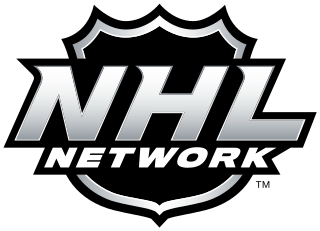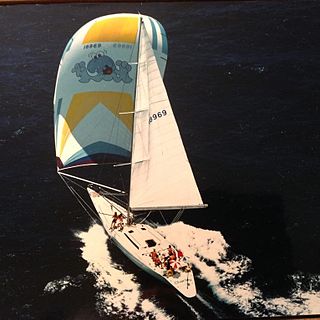Related Research Articles
FoxTrax, also referred to as the glowing puck, is an augmented reality system that was used by Fox Sports' telecasts of the National Hockey League (NHL) from 1996 to 1998. The system was intended to help television viewers visually follow a hockey puck on the ice, especially near the bottom of the rink where the traditional center ice camera was unable to see it due to the sideboards obstructing the puck's location. The system used modified hockey pucks containing shock sensors and infrared emitters, which were then read by sensors and computer systems to generate on-screen graphics, such as a blue "glow" around the puck, and other enhancements such as trails to indicate the hardness and speed of shots.

Fox Sports, also referred to as Fox Sports Media Group and stylized in all caps, is the sports programming division of the Fox Corporation that is responsible for sports broadcasts carried by the Fox broadcast network, Fox Sports 1 (FS1), Fox Sports 2 (FS2), and the Fox Sports Radio network.
The Sports Emmy Award for Outstanding Studio Show was first awarded in 1988. One sports studio show, whether a pregame or a nightly news show, was honored each year. In 2001, the category was split into two subcategories — Outstanding Studio Show, Daily and Outstanding Studio Show, Weekly, thus awarding two shows annually.

MLB on Fox is an American presentation of Major League Baseball (MLB) games produced by Fox Sports, the sports division of the Fox Broadcasting Company (Fox), since June 1, 1996. The broadcaster has aired the World Series in 1996, 1998, and every edition since 2000, and the All-Star Game in 1997, 1999, and every year since 2001. It has also aired the National League Championship Series (NLCS) and American League Championship Series (ALCS) in alternate years from 1996 to 2000 and since 2007, with the NLCS in even years and the ALCS in odd years.

1st & Ten is a computer system that augments televised coverage of American football by inserting graphical elements on the field of play as if they were physically present; the inserted element stays fixed within the coordinates of the playing field and obeys the visual rules of foreground objects occluding background objects. Developed by Sportvision and PVI Virtual Media Services, it is best known for generating and displaying a yellow first down line over a live broadcast of a football game—making it easier for viewers to follow play on the field. The line is not physically present on the field and is seen only by the television audience.

NHL Center Ice is an out-of-market sports package distributed by most cable and satellite providers in the United States and Canada. The package allows its subscribers to see up to forty out-of-market National Hockey League games a week using local and national television networks.

ESPN Major League Baseball is an American presentation of live Major League Baseball (MLB) games produced by ESPN. ESPN's MLB broadcasts have also aired on sister networks and platforms ESPN2, ABC since 2006, and ESPN+ since 2021.
The following is a chronological list of the technological advancements of Major League Baseball television broadcasts:

NHL Network is an American sports-oriented cable and satellite television network that is a joint venture between the National Hockey League (NHL), which owns a controlling 84.4% interest, and NBCUniversal, which owns the remaining 15.6%. Dedicated to providing broadcast coverage of ice hockey, the network features live game telecasts from the NHL and other professional and collegiate hockey leagues, as well as NHL-related content including analysis programs, specials and documentaries.
Virtual Replay is a technology which allows people to see 3D animations of sporting events. The technology was widely used during the 2006 FIFA World Cup. During this event, bbcnews.com posted highlights of the event on their websites soon after matches concluded and users could view the 3D renderings from multiple points of view.

TNT Sports is the division of Warner Bros. Discovery (WBD) that is responsible for sports broadcasts on its parent company's streaming service Max and on their various cable channels in the United States, including TBS, TNT, and TruTV. It also operates the online digital media outlets for the NCAA, NBA, PGA Tour, and PGA of America. TNT Sports also operates the sports news website Bleacher Report, as well as NBA TV on behalf of the NBA. It also owns a minority share in the MLB Network.
PITCHf/x is a system created and maintained by Sportvision that tracks the speeds and trajectories of pitched baseballs. This system, which made its debut in the 2006 Major League Baseball (MLB) postseason, is installed in every MLB stadium. The data from the system is often used by broadcasters to show a visual representation of the pitch and whether or not a pitch entered the strike zone. PITCHf/x is also used to determine the type of pitch thrown, such as a fastball, curveball or slider. MLB uses the data from PITCHf/x in its Zone Evaluation System which is used to grade and provide feedback to umpires. Sabermetric analysts note that umpire accuracy has improved after the technology was introduced to MLB.
In the United States, sports are televised on various broadcast networks, national and specialty sports cable channels, and regional sports networks. U.S. sports rights are estimated to be worth a total of $22.42 billion in 2019, about 44 percent of the total worldwide sports media market. U.S. networks are willing to pay a significant amount of money for television sports contracts because it attracts large amounts of viewership; live sport broadcasts accounted for 44 of the 50 list of most watched television broadcasts in the United States in 2016.
PVI Virtual Media Services is one of the companies behind the virtual yellow-down-line shown on television broadcasts of American football games in the United States and Canada. Founded in 1990 as Princeton Electronic Billboard, PVI Virtual Media Services was a wholly owned subsidiary of Cablevision Systems Corporation with a research and operations facility in Lawrenceville, NJ before being acquired by ESPN in December, 2010.

SMT is a business that specializes in graphics for broadcasts, webcasts and live events in sports and entertainment. They were the first company to employ real-time scoring and wireless data systems on television. SMT’s customers include broadcasting television networks, regional and specialty networks and sports governing bodies. In 2012 it acquired IDS as a division of the company to provide scoring, results and statistics on-site for live events. In 2016, SMT acquired Chicago-based rival Sportvision.

Stan Honey is an American professional offshore navigator with world sailing records and a businessman who founded Etak and Sportvision.
In September 2000, Major League Baseball signed a six-year, $2.5 billion contract with Fox to show Saturday baseball, the All-Star Game, selected Division Series games and exclusive coverage of both League Championship Series and the World Series.
On August 28, 2012, it was announced that ESPN and Major League Baseball had agreed on a new eight-year deal that increased ESPN's average yearly payment from about $360 million to approximately $700 million.

When the World Health Organization declared the COVID-19 pandemic in March 2020, all major professional and collegiate organizations responded by suspending operations indefinitely. This effect was passed down to the world of sports broadcasting, which includes live coverage of thousands of events on an annual basis through stations and network available over the air, through cable, satellite, and IPTV companies, and via streaming and over-the-top services.
References
- ↑ "Company Profile". Sportvision.
- ↑ Braff, Carolyn. "TBS, Sportvision Offer HD Viewers New Angles With PITCHf/x". Sports Video Group. Retrieved 31 March 2011.
- ↑ "NHL to unveil player-tracking for All-Star Game". Sportsnet.ca. 5 January 2015. Retrieved 7 January 2015.
- ↑ "Industry Powerhouse SMT Acquires Sportvision". Sportvision. 5 October 2016. Retrieved 4 December 2017.